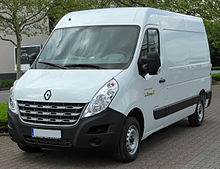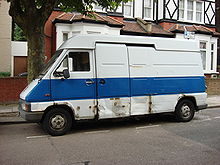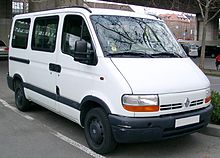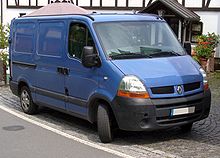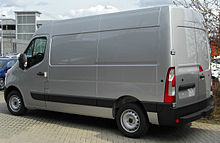- Renault Master
-
Renault Master is the name used by French vehicle manufacturer Renault for its upper-medium size van (around the GVW 3.5 tonne segment) — similar in size to the largest models of the more common Ford Transit.
Over its lifetime several different body styles have been available, from the standard van to bigger models with an increased load area, height, and longer-wheelbases with an LWB prefix. Panel vans are very common, but pickups are also available.
The Master was also sold by Volvo owned Renault Trucks as the B90 and B110[citation needed] and later as the Mascott[citation needed]. A range of horsebox conversions by Boss horseboxes and Theault are based on the Master.
Contents
First generation (1980–1997)
First generation Production 1980–1997 Layout FF Engine 2068cc 2.1D
2445cc 2.5D
1995cc 2.0 petrol
2165cc 2.2 petrolTransmission 5-speed manual The original Renault Master was launched in 1980. Originally launched with the 2.5 L (2445cc) Fiat-Sofim diesel engine, and from 1984 with the 2.1 L (2068cc) power unit.[1] In rare cases the Master was sold with a 2.0 L or 2.2 L Renault petrol engine.
They competed with a number of other manufacturer's products, but also with the smallest models of Renault's own Dodge 50 Series, which was latterly being built as the Renault 50 Series after Renault's acquisition of the UK Dodge production facilities (at the time of Peugeot's take-over of Chrysler Europe). The smaller Renault Trafic was also launched in 1980 resulting in a large range of light commercial vehicles.
The Master was distinctively styled with the sliding door design and unusual round door handles resemblant of the Fiat Ritmo/Strada. The van was manufactured at Renault's then new SoVAB Batilly plant in northeastern France.[2]
Renault B90 and B110
An alternative version, which appeared identical, was sold as by Renault Trucks as the Renault B90 and B110, and came with a range of alternative body options. A 4x4 version of the B90 took part in the Paris Dakar Rally in 1987.
Second generation (1997–2010)
Second generation Production 1997–2010 Layout FF Engine 2445cc 2.5D
2799cc 2.8D
2188cc 2.2 dCi
2488cc 2.5 dCi 100PS/120PS/150PSTransmission 5-speed manual
6-speed manual
6-speed Quickshift semi-autoThe second generation Renault Master is more conventional in appearance and, though primarily developed by Renault, is also available as the almost identical Opel Movano (badged in the UK as the Vauxhall Movano), and from Renault's closely related partner Nissan, when it is renamed the Nissan Interstar; the arrangement mirrors the collaboration between these companies on the Master's smaller counterpart, the Renault Trafic.
The Master used the Renault S-Type engine in SxU and SxW versions, the G-Type engine (G9T) and the YD engine.
The van received a mid-life major facelift with the headlight area being heavily restyled, resulting in the front end somewhat resembling the smaller Trafic. Like its predecessor, the van was available in a number of sizes and configurations, and was a popular base for conversion to ambulance bodywork.
Renault Mascott
Renault Mascott Production 1999–2010 Layout FR Engine 2799cc 2.8D 115PS
2953cc 3.0 dCi 120PS/160PSTransmission 5-speed manual
6-speed manualRenault Trucks marketed a heavy duty 3.0 L diesel version of the Master and sold it as the Mascott[citation needed]. Available in Europe between 1999 and 2010, it was positioned between the Master and the larger Renault Midlum.[3] It was available in two states of tune, either 120 bhp (89 kW; 122 PS) or 160 bhp (119 kW; 162 PS) with five and six speeds respectively.
Current generation (2010–)
Third generation Production 2010– Layout FF
FREngine 2298 2.3 dCi 100PS/120PS/150PS Transmission 6-speed manual
6-speed Quickshift semi-autoA new generation of the Renault Master was introduced in May 2010, sharing the same platform with the Opel Movano and the Nissan NV400.
Renault Trucks discontinued the Mascott and sold the third generation Master in chassis cab format only, with payloads of up to 2.5 tonnes.[4]
References
« previous — Renault car timeline, 1980s–present Type 1980s 1990s 2000s 2010s 0 1 2 3 4 5 6 7 8 9 0 1 2 3 4 5 6 7 8 9 0 1 2 3 4 5 6 7 8 9 0 1 City car 4 Twingo Twingo II Supermini 5 / 7 Super 5 Clio I Clio II Clio III Symbol I Symbol II Small
family car14 9 / 11 19 Mégane I Mégane II Mégane III Alliance / Encore Fluence Large
family car18 21 / Medallion Laguna I Laguna II Laguna III Latitude Executive car 20 / 30 25 Safrane Vel Satis Leisure activity vehicle Express Kangoo I Kangoo II SUV Koleos Mini MPV Modus Compact MPV Scénic I Scénic II Scénic III Large MPV Espace I Espace II Espace III Espace IV Coupé Fuego Avantime Laguna Coupé Roadster Spider Wind Van Trafic I Trafic II Master I Master II Master III Renault S.A. Current: Numeric: 1970–2009: 1945–1970: Between wars: Celtaquatre • Monaquatre • Juvaquatre • Monasix • Nervastella • NN • Novaquatre • Primaquatre • Reinastella • Viva Grand Sport • Vivaquatre • Vivasix • Vivastella •Type MTPre-WWI: 10CV • 12CV • 35CV • 40CV • L/M • N(a)/N(b)/S • N(c)/Q/U(a/e) • R/T • U • AS/V • Taxi de la Marne • Towncar • Voiturette • X/X-1 • YAlpine: Renault Sport: Grand Prix de l'A.C.F. • 5 Turbo • Clio Williams • Clio Renault Sport • Spider • Mégane Renault Sport • Clio V6 Renault SportConcept vehicles: Alpine 210 RS • Altica • Argos • Be Bop • BRV • Captur • DeZir • Ellypse • Espace F1 • EPURE • Evado • EVE • Egeus • Etoile Filante • Fiftie • Fluence • Frendzy • Initiale • Koleos • Laguna • Mégane • Nepta • Next • Ondelios • Racoon • R-Space • Sand'up • Scénic • Steppe • Talisman • Twizy Z.E. • VESTA 2 • Wind • Z.E. Concept • Zo • Zoe • ZoomVans and trucks: Dacia (current): Dacia (2000–2006): Renault Samsung: Formula One: See also: AvtoVAZ (25%) • Renault-Nissan Alliance
 Category ·
Category ·  CommonsCategories:
CommonsCategories:- Renault vehicles
- Vans
- Vehicles introduced in 1980
- Van stubs
Wikimedia Foundation. 2010.

